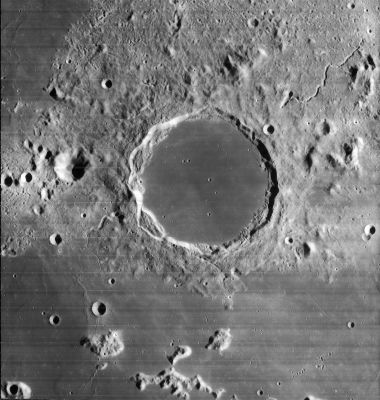Bliss
Contents
[hide]Bliss (aka Jackson-Gwilt)
(formerly Plato A)|
Lat: 53.0°N, Long: 13.5°W, Diam: 20 km, Depth: km, Rükl: 3 |

Lunar Orbiter IV-127-H3 (submitted by Stefan Lammel). Bliss is the somewhat irregular bowl-shaped crater to the left (west) of Plato. The IAU's Alpes A (also classically known as Plato A or A') is out of the field to the right.
Images
LPOD Photo Gallery Lunar Orbiter Images
Maps
(LAC zone 12D1) LAC map Geologic map
Description
Description: Wikipedia
Additional Information
- Plato M, a bright craterlet with high-albedo ejectablanket (west of Bliss) looks remarkably light-bluish when it is observed during Full Moon.- DannyCaes Jun 28, 2008
Nomenclature
- Named for Nathaniel Bliss (November 28, 1700 – September 2, 1764), a noted English astronomer of the 18th century, serving as Astronomer Royal between 1762 and 1764. He succeeded Edmond Halley as professor of geometry at Oxford University in 1742 and was elected a Fellow of the Royal Society the same year. He succeeded James Bradley to become the fourth Astronomer Royal in 1762.
- According to Mary Blagg's Collated List (1913), this crater (catalog #1064) was labeled Plato A (or possibly Plato A (1) ) by Mädler, a convention followed by Neison and Schmidt. She also notes (p. 182) that the name Gwilt (J.) or perhaps Jackson-Gwilt was reported to have been in use in England (presumably Birt), but not used on any of the classic maps.
- The name Plato A was adopted into the original IAU nomenclature of Named Lunar Formations (1935).
- A smaller unrelated crater far to the east of Plato also labeled by Mädler (according to Blagg) as Plato A (or possibly Plato A(2)) and known to Neison as Plato A' -- catalog #1065 -- was adopted into the IAU nomenclature as Alps A (presumably substituting as its "patronymic" feature Montes Alpes -- then known as Alps -- for Plato). Catalog #1065 is currently known as Alpes A.
- Sometime between 1997 and 2000, the official name of catalog #1064 was changed from Plato A to Bliss. The change was announced in IAU Transactions XXIVB (2000). The reason for the change is not indicated.
- The Wikipedia article about this feature claims the change was proposed by Patrick Moore because Nathaniel Bliss was, at that time, the only Astronomer Royal not to have an astronomical body or planetary surface feature named after him. It is also claimed that the change was originally announced in a bulletin saying the feature to be named Bliss was not the present feature, but the one informally known as Ancient Newton. No references for these claims are provided.
- The idea that Moore intended to assign the name Bliss to Ancient Newton, rather than the present feature, is repeated in a 2006 book by Tony Buick, which is part of a series edited by Moore.
- The craterlets on the floor of Plato have also been informally lettered in some amateur guides to the Moon, the largest of these (near the center of the floor) having been referred to as A (or Plato A or Plato craterlet A?) in some of these schemes. - Jim Mosher
- A hill north-northeast of Bliss seems to have been called Plato Rho, and another one south of Bliss was just "Eta" (Plato Eta?) (see Charts 2 and 3 in the Times Atlas of the Moon).
LPOD Articles
Peach-Pod (an extraordinary close-up of Plato, with Bliss west of it).
Tell me a Story
Blissfully Deep
Bibliography
- "Jackson-Gwilt" (Plato A): MaanMonografieen, Tony Dethier (V.V.S. - Vereniging Voor Sterrenkunde, 1989).
- Whitaker, Ewen A. Mapping and Naming the Moon, (page 221, Appendix J).
- Blagg, Mary and Müller, Karl. Named Lunar Formations, .
- Moore, Patrick. New Guide to the Moon, (page 256, Section 6).